题目翻译:学习 local feature descriptors 使用 triplets 还有浅的卷积神经网络。读罢此文,只觉收获满满,同时另外印象最深的也是一个浅(文章中会提及)字。
1 Contribution
这篇论文主要做的贡献有:
- 提出了一种复杂度更小的triplets,更浅,计算度复杂小,表现也很好。
- 并且借助一种 in-triplet mining的训练方法,降低了挖掘hard negatives的复杂度提高了表现。
- 论文还介绍了两种不同的loss function在不同的任务下的表现。
下面将围绕这些贡献展开说明:
2 Learning with pairs
这一小节作者介绍了一下孪生神经网络的训练方法。
\(\ell=1\)代表\(x_1,x_2\)是positive pairs,反之则是negative pairs。同时当模型训练到一定程度,negative pairs所产生的loss就是0了,对模型的训练不起作用,因此之前[4]提出了mining hard negatives的方法来应对,具体可见我的上一篇博文,同时这种方法代价很高。
3 Learning with triplets
我们假设取样有\(\{a,p,n\}\),\(a\)和\(p\)来自同一个关键点的不同视角,\(a\)和\(n\)则来自不同的关键点,那么训练的目的是尽量使得\(a\)和\(p\)得到的特征描述更近,\(a\)和\(n\)得到的特征描述更远。因此我们可以定义\(\delta_{+}=\|f(\boldsymbol{a})-f(\boldsymbol{p})\|_{2}\) and \(\delta_{-}=\|f(\boldsymbol{a})-f(\boldsymbol{n})\|_{2}\)。
3.1 Two loss functions
-
Margin ranking loss
\[\lambda\left(\delta_{+}, \delta_{-}\right)=\max \left(0, \mu+\delta_{+}-\delta_{-}\right) \]我们可以观察到,当\(\delta_{-}>\delta_{+}+\mu\)时,\(loss>0\),模型得到训练。
-
Ratio loss
模型得到训练当 \(\frac{\delta_{-}}{\delta_{+}} \rightarrow \infty\).训练目标是尽可能让 \(\left(\frac{e^{\delta_{+}}}{e^{\delta_{+}+} e^{\delta_{-}}}\right)^{2}\) to 0 , and \(\left(\frac{e^{\delta_{-}}}{e^{\delta++e^{\delta}}}\right)^{2}\) to 1。
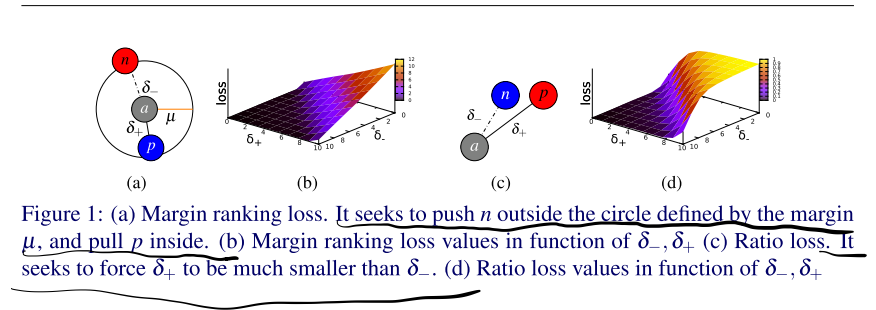
3.2 In-triplet hard negative mining with anchor swap
这篇论文的第一个令人拍手称快的点在这里!
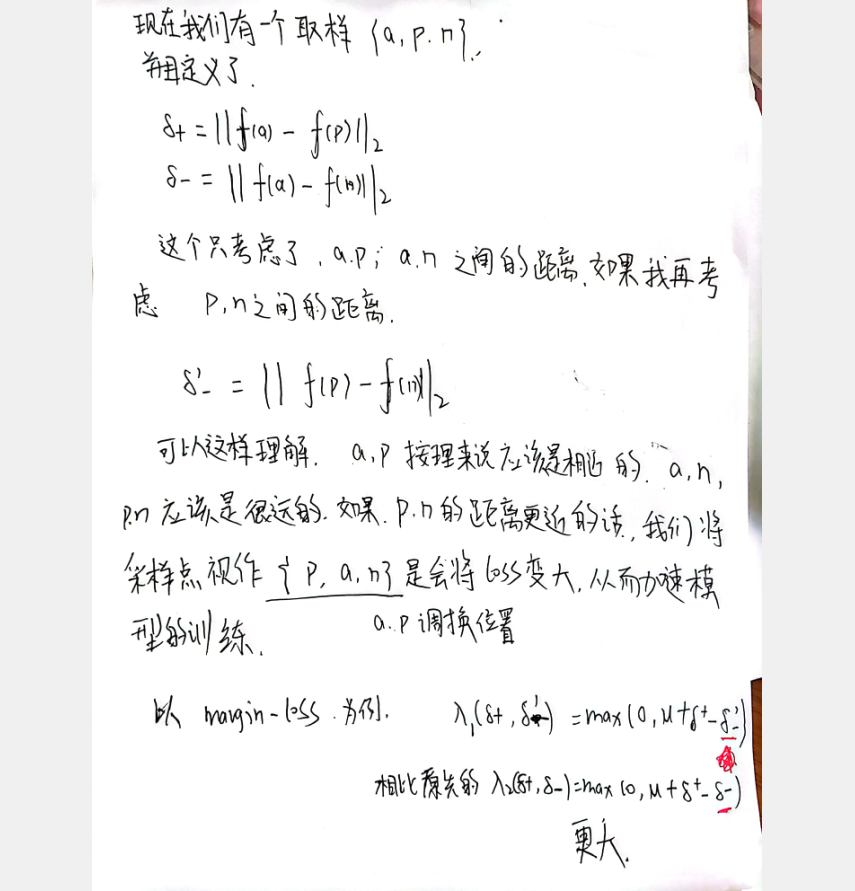
类似的思想对Ratio loss同样适用。
3.3 Implementation details
这一小节主要介绍了,训练上的一些细节,模型结构很简单。

同时引用原文里的一句话,阐述了为何把模型设置的尽量简单。
Our motivation for such shallow network is to develop a descriptor for practical applications including those requiring real time processing. This is a challenging goal given that all previously introduced descriptors are computationally very intensive, thus impractical for most applications.
4 Experimental evaluation
这一节作者介绍了从两个方面评估模型的方法,一个是 ROC curves,另一个是mean average precision,刚开始不知道这两个指标是怎么来的,做什么的,查阅了参考小节里的文章,有了一个大致的认识,关于这两种评估方法的一些介绍引用原文:
The evaluation is done with two different evaluation metrics frequently found in the literature, patch pair classification success in terms of ROC curves [22], and mean average precision in terms of correct matching of feature points between pairs of images [16]. Note that these two metrics are of very different nature,the former measures how succesfull a classification of positive and negative patch pairs is, and the latter is evaluating the performance of a descriptor in nearest neighbour matching scenario where the task is to find correspondences in two large sets of descriptors.
4.1 Patch pair classification
可以看到在相关数据集上的FPR95指数,TFeat(论文模型的名字)要表现更好:
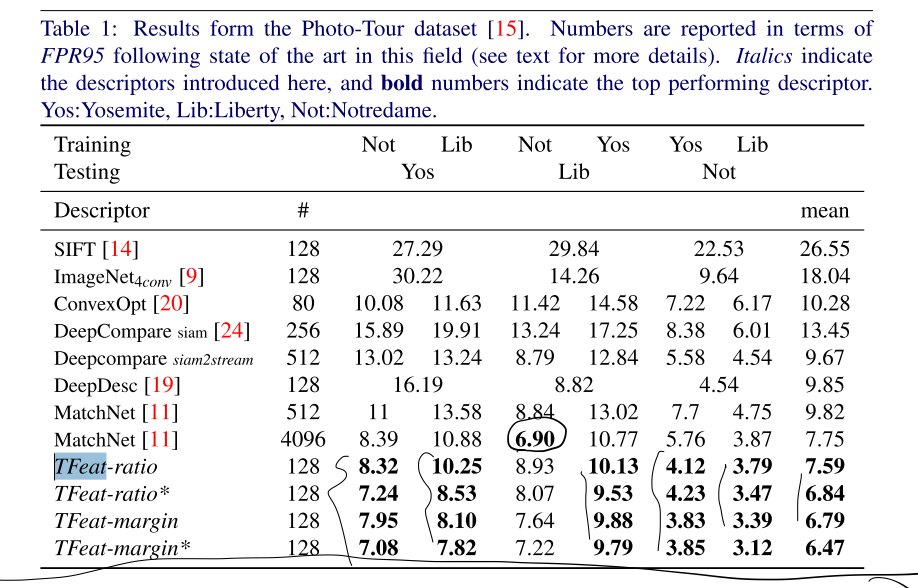
4.2 Nearest neighbour patch matching
这一小节作者介绍了结合数据集的一些采样方法来计算precision-recall cruves,关于Map指标的一些相关介绍,可查阅附录,这里就不过多展开了
-
Ratio loss vs. margin loss
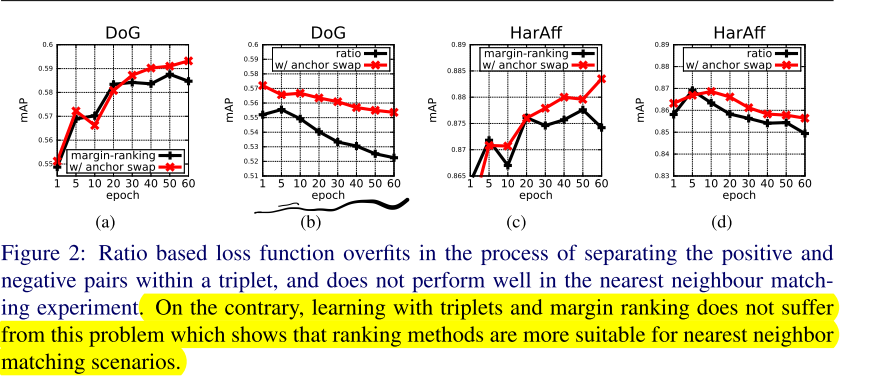

- 大致可以发现map值的变化随epoch的变化是比较缓慢的。
- radio loss 随着训练在Nearest neighbour patch matching上表现会**越来越差**
- 问:那这样说的话,Ratio loss除了在起点处略优于margin loss,在什么方面会比margin loss好呢?- Image transformations
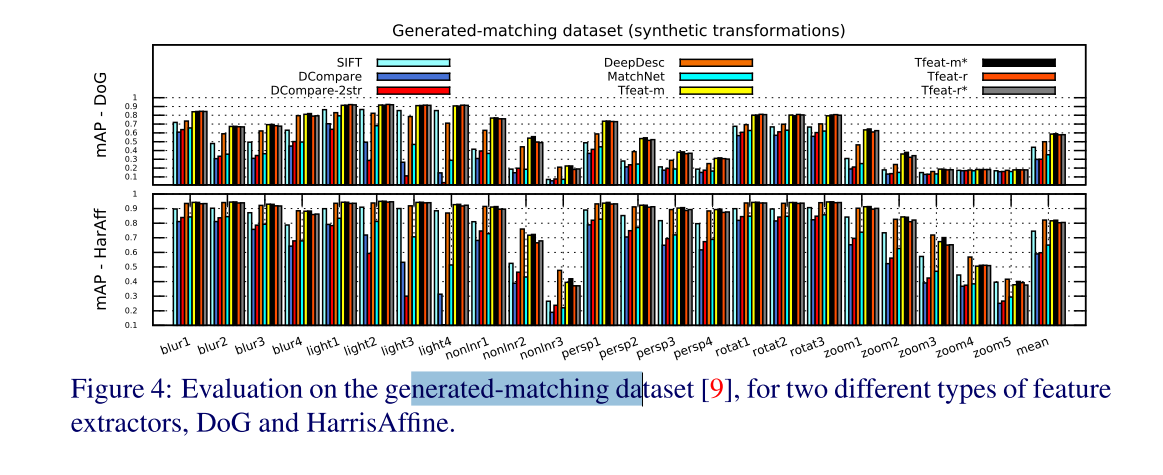
This shows that synthetic deformations are less challenging for descriptors than some real-world changes as the ones found in Oxford dataset.
5 Efficiency
Tfeat,体量更小,运算更快,效果更好。
6 Summary
- 提出了一个体量更小的模型,同时设计了一个方法使得训练结果更好
- 阐述 ratio-loss based methods 更适合 patch pair classification, margin-loss based methods 在 nearest neighbour matching 表现更好。这里我怀疑是作者第一句说错了,因为在ratio-loss的在patch pair classification 测试结果(4.1 Patch pair classification)上,并没有比 margin-loss好,事实上,这篇论文里我没有找到地方证明ratio-loss在哪里优于margin-loss.....
- a good performance on patch classification does not necessarily generalise to a good performance in nearest neighbour based frameworks.
Refer
[1] TPR FPR ROC AUC:https://zhuanlan.zhihu.com/p/100059009
[2] FPR95:https://stats.stackexchange.com/questions/481991/false-positive-rate-at-k-recall
[3] MAP:https://www.zhihu.com/question/53405779
[4] E. Simo-Serra, E. Trulls, L. Ferraz, I. Kokkinos, P. Fua, and F. Moreno-Noguer. Discriminative learning of deep convolutional feature point descriptors. In ICCV, 2015.






















 4621
4621











 被折叠的 条评论
为什么被折叠?
被折叠的 条评论
为什么被折叠?










